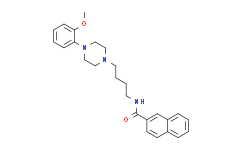| Description: |
BP 897 is a potent and selective dopamine D3 receptor agonist, and a weak dopamine D2 receptor antagonist, with Kis of 0.92 nM and 61 nM for D3 and D2 receptors, and shows low affinities at D1 and D4 receptors (Kis, 3 and 0.3 µM, respectively). |
| Target: |
Ki: 0.92 nM (D3 receptor), 61 nM (D2 receptor), 0.3 µM (D4 receptor), 3 µM (D1 receptor)[1]. |
| In Vivo: |
BP 897 binds to D2-receptor in mouse striatum with an ED50 of 15 mg/kg, and the D3-receptor occupancy is blow 0.5 mg/kg. BP 897 (0, 0.05, 0.5, 1 mg/kg) inhibits cocaine-seeking behaviour that depends upon the presentation of drug-associated cues, without having any intrinsic, primary rewarding effects[1]. |
| In Vitro: |
BP 897 is a potent and selective dopamine D3 receptor agonist, and a weak dopamine D2 receptor antagonist, with a Ki of 0.92 nM for D3 receptor, a 70 times lower affinity at the D2 receptor (Ki, 61 nM), and shows low affinities at D1 and D4 receptors (Ki = 3 and 0.3 µM, respectively). BP 897 also weakly binds to α1 and α2 adrenergic receptors (Ki = 60 and 83 nM, respectively), 5HT1A and 5HT7 receptors (Ki = 84 and 345 nM, respectively), and has negligible affinities (Ki > 1 µM) at muscarinic, histamine and opiate receptors. BP 897 inhibits forskolin-induced cyclic AMP accumulation with an EC50 of 1.0 ± 0.3 nM, and increases mitogenesis, another D3-receptor-mediated response (EC50 = 3 ± 1 nM) in NG 108-15 cells expressing the human D3 receptor. However, BP 897 (1 µM) does not inhibit cyclic AMP accumulation or trigger mitogenesis in cells expressing the D2 receptor[1]. |
| References: |
[1]. Pilla M, et al. Selective inhibition of cocaine-seeking behaviour by a partial dopamine D3 receptor agonist. Nature. 1999 Jul 22;400(6742):371-5. |






















